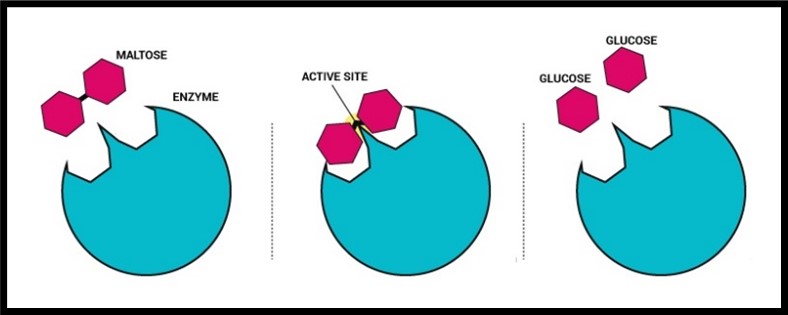
By Malcolm Bucholtz, Owner and Distillation Instructor
Prohibition University
http://www.prohibitionuniversity.com/
Published: 27-November-2020
Enzymes
In a previous article, I discussed the structure of proteins. An enzyme is a protein substance that has special binding sites in its structure. An enzyme hastens a chemical process or reaction. An enzyme is not destroyed or altered during the chemical process. Enzymes are widely used in the brewing and distilling industry.
Sometimes enzymes are referred to as ‘artificial enzymes’. But there is nothing artificial about them. The concept of enzymes dates to 1913 and German scientist Otto Rohm who investigated the use of enzymes from the pancreatic tissue of slaughtered animals. But, enzymes do not just come from animals. In my collection of papers, I have one manuscript (1) from 1952 that describes how researchers took a 4% sucrose solution and to it added Aspergillus Oryzae fungus. The fungus obviously could sense the osmotic pressure from the dense sucrose in solution. Instinctively, the fungus knew that it was surrounded by food. The fungus started secreting a milky liquid which was designed to break down the sucrose molecules into glucose and fructose so that they could be digested. The milky secretion was protein enzyme material. In more modern parlance, the big enzyme makers have stainless steel reactor vessels in which they place fungus plus food. As the fungus secretes protein material, the material is filtered off and refined for packaging and sale to brewers and distillers. Different enzyme types are generated under different process conditions. Today, the fungal matter used is Aspergillus Oryzae and Aspergillus Niger.
Think of an enzyme as a piece in a jig-saw puzzle. It takes a certain piece to match up with another piece of the puzzle.
Figure 1 attempts to illustrate further (2). In this example, a molecule of maltose in a grain mash attaches to the binding site on an enzyme molecule, just like two pieces of a jig-saw puzzle coming together. The enzyme lowers the activation energy of the bond joining the two halves of the maltose molecule and the heat energy in the mash kettle then can sever the maltose into two bits. The two bits then leave the binding site. The enzyme is then free and available to visit with other maltose molecules. This substrate-binding site model was first conceived in 1894 by scientist Emil Fischer who termed it the lock-and-key model.
From KYOCP website (2012)
If enzymes seem like a foreign subject, they ought not be. Although consumers do not know it, their lives have been impacted by enzymes. The next time you do a load of laundry, bear in mind your detergent contains amylase and glucoamylase enzymes which break down the proteins and carbohydrates in the food stains on your dirty shirt to be laundered.
The next time you reach for your wallet, consider that the leather has been made soft thanks to protease enzymes that have partly broken down the leather protein structure. The next time you see a new pair of ripped, faded, denim jeans in the store, know that laccase enzymes have been used to partly degrade the denim (cotton) fabric.
The next time you drink a commercially-made lager style beer and wonder how it can be made so clear, the answer in large part rests with alpha acetolactate decarboxylase enzymes that were used to break down any protein haze.
The next time you brush your teeth, there are a series of reactions that will occur in your mouth. Amylase and glucoamylase enzymes will break down the foodstuff on your teeth into glucose. A glucooxidase enzyme in the toothpaste will oxidize glucose to hydrogen peroxide. A lactoperoxidase enzyme in the toothpaste will then oxidize the thiocyanate in your saliva into hypothiocyanite which is an antibacterial, which keeps your mouth fresh.
Amylases, xylanases and lipases are used in the paper making industry.
Phytases are now being added to animal feeds to help digestion and reduce flatulence, which is a greenhouse gas!
And here is the big one. The one that is killing us all. Look on many food packages in the grocery store and you will see high fructose corn syrup being used as a cheap additive. Take a mash of corn, heat it with an amylase enzyme to break down the starches. Now add an enzyme called glucose isomerase and the glucose sugar molecule will re-arrange itself into a fructose molecule (3). This re-arranged molecule tastes sweeter than ordinary sugar. Hence, food makers get away with adding less of it to get the same degree of sweetness at the end of the game. Problem is, our bodies do not readily like to consume this high fructose stuff and our cellular tissues will store it in our system as fat. Fat in excess leads to disease.
There are a number of enzyme makers in the world. The largest is Novozymes, headquartered in Denmark. In North America, a California-based company called Gusmer Enterprises is the selling agency for Novozymes products. Another large concern is BSG (Brewer’s Supply Group), a wholly owned subsidiary of German malting company Rahr. And another large player to bear in mind is Dupont Chemical. As home brewer or home distiller, there is some recent good news to be aware of. Up until perhaps a year ago it was difficult for the average home enthusiast to source enzymes. Now, BSG has stepped up to the plate. Visit your local home brewing supply shop and ask if they can sell you HiTempase, Bioglucanase and Amylo 300 from BSG. If they do not have these products in stock, they will be able to get them for you. When you get the enzymes, keep them in the refrigerator. They actually will maintain their viability for several years beyond the best before date stated on the container providing you refrigerate them. In late 2020 I used up the last bits of some BSG enzymes that were labelled as being best before July 2016.
In a future article, I will review the procedure for using enzymes in a grain mash.
References
- Crewther, W.G., Lennox, F.G. (1953). Enzymes of Aspergillus Oryzae. Australian Journal of Biological Sciences, 6(3), pp 410-427.
- KYOCP website (2012) Enzymes. [online]. Available at: https://kyocp.wordpress.com/2012/12/07/enzymes/ [Accessed: December 2018].
- Novozymes website (2020) Enzymes at Work. [online] Available at: http:n ovozymes.com [Accessed October 2020].
About the Author: Malcolm Bucholtz, M.Sc is a long time home brewer and consultant to the craft distilling industry. Visit his website at: www.ProhibitionUniversity.com

There is evidently a bundle to know about this. I feel you made certain nice points in features also.
Have you ever considered about including a little bit more than just your articles? I mean, what you say is fundamental and all. But think about if you added some great graphics or video clips to give your posts more, “pop”! Your content is excellent but with images and videos, this website could undeniably be one of the greatest in its field. Fantastic blog!
how to make a great article like this?
Glorious data here. This interesting post made me smile. Possibly should you throw in a few pictures it would make the entire thing extra interesting. Anyway, in my language, there usually are not much good supply like this.
Thank you for your comment. I agree that our authors articles are a great source of information. I will pass along your request for more pictures to Malcolm and see what he can do. Cheers!
When I originally commented I clicked the “Notify me when new comments are added” checkbox
and now each time a comment is added I get four e-mails with
the same comment. Is there any way you can remove me from that service?
Appreciate it!
Hi, we apologize that you are getting all these emails. You are the first to mention this.
I’m having difficulty finding your user account with this email address to turn this off. Is it possible that you used a different email address?
Regards
Still on Tap
I am really loving the theme/design of your site. Do you ever run into any web browser compatibility problems?
A couple of my blog visitors have complained about my website not working
correctly in Explorer but looks great in Firefox. Do you have any recommendations to help fix this problem?
Hi Finnley
Thank you for visiting our site and the positive review.
The best suggestions I can offer is the take advantage of a development site if it’s available and test changes there before you promote things to production.
Keep to higher rated themes and keep the theme and plugins updated.
I hope this helps.
You can certainly see your skills in the work you write.
The arena hopes for more passionate writers like you who aren’t afraid to mention how they believe.
Always go after your heart.
Greetings I am so grateful I found your blog, I really found you
by mistake, while I was looking on Digg for something
else, Anyhow I am here now and would just like
to say cheers for a tremendous post and a all round thrilling
blog (I also love the theme/design), I don’t have time to
read it all at the minute but I have bookmarked it and also added in your RSS
feeds, so when I have time I will be back to read much
more, Please do keep up the fantastic work.
Hi Haaris
Thank you for visiting our site and the positive review. We are happy to hear back from our followers.
Still On Tap
I want to to thank you for this great read!! I absolutely loved every bit of it.
I’ve got you book-marked to look at new things you post…
Thank you for visiting our site. We are happy that you are enjoying the articles.
Still on Tap
“An interesting discussion is worth comment. I do think that you need to publish more about this subject, it may not be a taboo matter but typically people do not discuss such issues. To the next! Cheers!!”